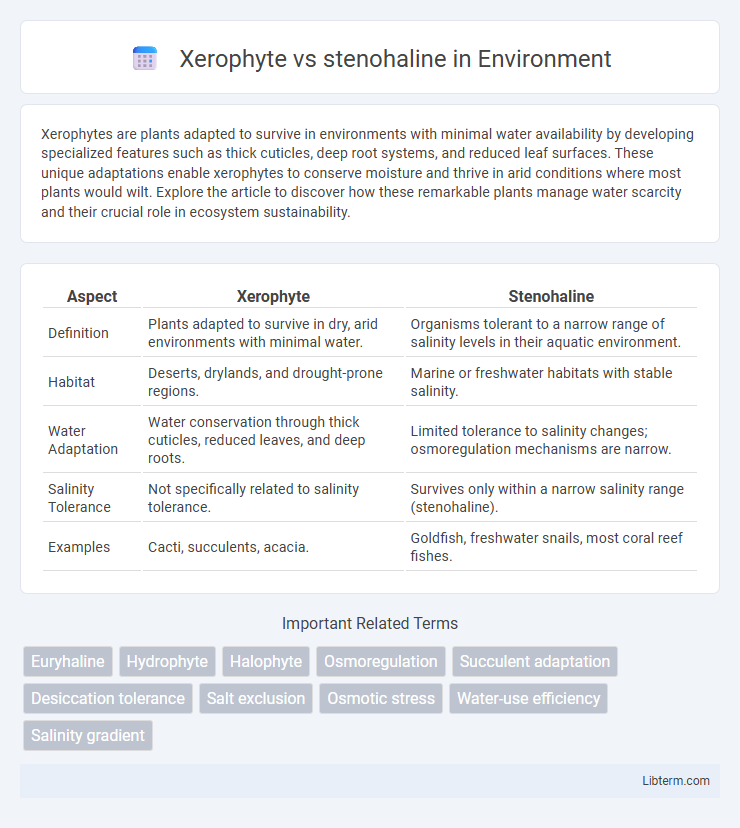Xerophytes are plants adapted to survive in environments with minimal water availability by developing specialized features such as thick cuticles, deep root systems, and reduced leaf surfaces. These unique adaptations enable xerophytes to conserve moisture and thrive in arid conditions where most plants would wilt. Explore the article to discover how these remarkable plants manage water scarcity and their crucial role in ecosystem sustainability.
Table of Comparison
| Aspect | Xerophyte | Stenohaline |
|---|---|---|
| Definition | Plants adapted to survive in dry, arid environments with minimal water. | Organisms tolerant to a narrow range of salinity levels in their aquatic environment. |
| Habitat | Deserts, drylands, and drought-prone regions. | Marine or freshwater habitats with stable salinity. |
| Water Adaptation | Water conservation through thick cuticles, reduced leaves, and deep roots. | Limited tolerance to salinity changes; osmoregulation mechanisms are narrow. |
| Salinity Tolerance | Not specifically related to salinity tolerance. | Survives only within a narrow salinity range (stenohaline). |
| Examples | Cacti, succulents, acacia. | Goldfish, freshwater snails, most coral reef fishes. |
Introduction to Xerophytes and Stenohaline Organisms
Xerophytes are plants adapted to survive in arid environments with minimal water availability, characterized by features like thick cuticles, reduced leaf surface area, and deep root systems. Stenohaline organisms are aquatic species that tolerate a narrow range of salinity, often restricted to either fresh or marine waters, making them sensitive to salinity fluctuations. Understanding the adaptations of xerophytes and stenohaline organisms highlights the evolutionary strategies for coping with extreme environmental stressors such as drought and salinity.
Defining Xerophytes: Adaptations to Arid Environments
Xerophytes are plants adapted to survive in arid environments by developing features such as thick cuticles, reduced leaf surface area, and deep root systems to minimize water loss and maximize water absorption. These adaptations enable xerophytes to maintain cellular functions under prolonged drought conditions, contrasting with stenohaline organisms that tolerate only narrow salinity ranges. Understanding xerophyte adaptations highlights their crucial role in ecosystem stability within deserts and other water-scarce habitats.
Understanding Stenohaline: Tolerance to Salinity
Stenohaline organisms have a narrow tolerance to salinity variations, thriving only in environments with stable salt concentrations, unlike xerophytes that are adapted to arid conditions with minimal water availability. These organisms maintain osmotic balance through specialized cellular mechanisms to survive in marine or brackish waters where salinity fluctuations are limited. Understanding stenohaline tolerance is crucial for studying ecosystems like coral reefs or estuaries, where precise salt levels support biodiversity.
Key Differences Between Xerophytes and Stenohaline Organisms
Xerophytes are plants adapted to survive in arid environments with minimal water, exhibiting features like thick cuticles, reduced leaf surface area, and deep root systems to minimize water loss. Stenohaline organisms, on the other hand, are aquatic species that can tolerate only a narrow range of salinity, making them vulnerable to fluctuations in salt concentration. The key difference lies in their environmental adaptations: xerophytes are specialized for drought resistance, while stenohaline organisms are restricted by salinity tolerance.
Physiological Mechanisms in Xerophytes
Xerophytes exhibit specialized physiological mechanisms such as CAM photosynthesis and reduced stomatal density to minimize water loss in arid environments. Their thick cuticles and extensive root systems enhance water retention and absorption under drought stress. In contrast, stenohaline organisms primarily regulate ion balance and osmotic pressure for survival in narrow salinity ranges, without such extensive water conservation adaptations.
Salinity Regulation in Stenohaline Species
Stenohaline species maintain salinity regulation through specialized osmoregulatory mechanisms that limit their survival to narrow salinity ranges, using ion transporters and gill chloride cells to balance internal ion concentrations. These organisms rely heavily on active ion pumping and excretion processes to prevent osmotic stress caused by fluctuating external salinities. Unlike xerophytes that adapt to water scarcity, stenohaline species possess limited physiological flexibility, confining them to stable saline environments.
Ecological Roles and Habitats
Xerophytes, adapted to arid environments, play crucial ecological roles by stabilizing soil and conserving water in deserts and dry regions, supporting biodiversity through microhabitats. Stenohaline organisms, restricted to stable salinity habitats such as freshwater or marine environments, contribute significantly to ecosystem balance by maintaining species-specific niches and trophic interactions. Their adaptations reflect evolutionary responses to habitat-specific stressors, influencing ecological succession and community structure.
Examples of Xerophyte Species
Xerophytes are plants adapted to survive in arid environments with limited water availability, examples include cacti such as *Carnegiea gigantea* (saguaro) and succulents like *Agave americana*. In contrast, stenohaline organisms, such as certain freshwater fish species like *Oncorhynchus mykiss* (rainbow trout), tolerate only a narrow range of salinity. Xerophyte species exhibit specialized features like thick cuticles and deep root systems to conserve water, distinguishing them clearly from stenohaline species primarily defined by salinity tolerance.
Examples of Stenohaline Species
Stenohaline species such as the Atlantic cod (Gadus morhua) and the marine crab (Carcinus maenas) require stable salinity levels, thriving primarily in oceanic environments with limited tolerance to salinity fluctuations. These organisms contrast with xerophytes, which are adapted to survive in arid conditions with minimal water availability. The narrow salinity tolerance of stenohaline species makes them sensitive indicators of environmental changes in marine ecosystems.
Importance in Environmental Adaptation and Biodiversity
Xerophytes exhibit adaptations for water scarcity, enabling survival in arid environments and contributing to ecosystem stability by preventing desertification. Stenohaline organisms, tolerant to narrow salinity ranges, maintain biodiversity in specific aquatic niches, influencing community structure and ecosystem resilience. Both groups play crucial roles in environmental adaptation, supporting diverse habitats and sustaining ecological balance amid changing climatic conditions.
Xerophyte Infographic

 libterm.com
libterm.com